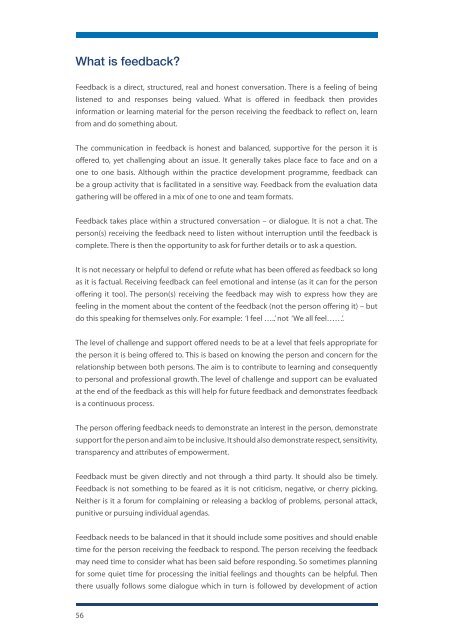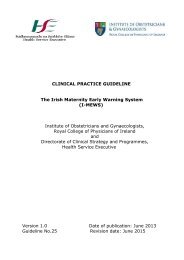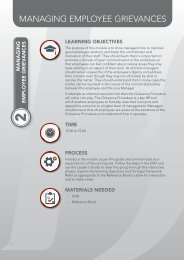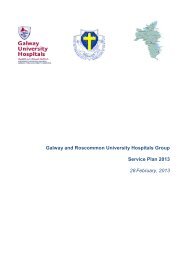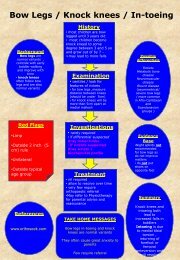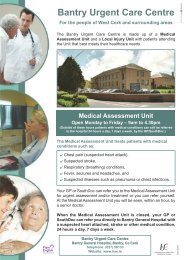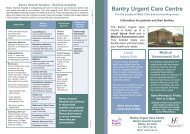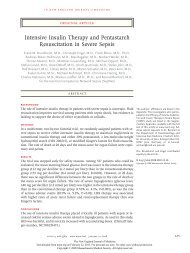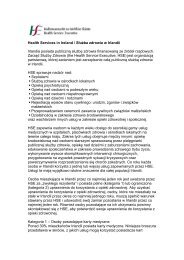Enhancing Care for Older People - Health Service Executive
Enhancing Care for Older People - Health Service Executive
Enhancing Care for Older People - Health Service Executive
You also want an ePaper? Increase the reach of your titles
YUMPU automatically turns print PDFs into web optimized ePapers that Google loves.
What is feedback?<br />
Feedback is a direct, structured, real and honest conversation. There is a feeling of being<br />
listened to and responses being valued. What is offered in feedback then provides<br />
in<strong>for</strong>mation or learning material <strong>for</strong> the person receiving the feedback to reflect on, learn<br />
from and do something about.<br />
The communication in feedback is honest and balanced, supportive <strong>for</strong> the person it is<br />
offered to, yet challenging about an issue. It generally takes place face to face and on a<br />
one to one basis. Although within the practice development programme, feedback can<br />
be a group activity that is facilitated in a sensitive way. Feedback from the evaluation data<br />
gathering will be offered in a mix of one to one and team <strong>for</strong>mats.<br />
Feedback takes place within a structured conversation – or dialogue. It is not a chat. The<br />
person(s) receiving the feedback need to listen without interruption until the feedback is<br />
complete. There is then the opportunity to ask <strong>for</strong> further details or to ask a question.<br />
It is not necessary or helpful to defend or refute what has been offered as feedback so long<br />
as it is factual. Receiving feedback can feel emotional and intense (as it can <strong>for</strong> the person<br />
offering it too). The person(s) receiving the feedback may wish to express how they are<br />
feeling in the moment about the content of the feedback (not the person offering it) – but<br />
do this speaking <strong>for</strong> themselves only. For example: ‘I feel …..’ not ‘We all feel……’.<br />
The level of challenge and support offered needs to be at a level that feels appropriate <strong>for</strong><br />
the person it is being offered to. This is based on knowing the person and concern <strong>for</strong> the<br />
relationship between both persons. The aim is to contribute to learning and consequently<br />
to personal and professional growth. The level of challenge and support can be evaluated<br />
at the end of the feedback as this will help <strong>for</strong> future feedback and demonstrates feedback<br />
is a continuous process.<br />
The person offering feedback needs to demonstrate an interest in the person, demonstrate<br />
support <strong>for</strong> the person and aim to be inclusive. It should also demonstrate respect, sensitivity,<br />
transparency and attributes of empowerment.<br />
Feedback must be given directly and not through a third party. It should also be timely.<br />
Feedback is not something to be feared as it is not criticism, negative, or cherry picking.<br />
Neither is it a <strong>for</strong>um <strong>for</strong> complaining or releasing a backlog of problems, personal attack,<br />
punitive or pursuing individual agendas.<br />
Feedback needs to be balanced in that it should include some positives and should enable<br />
time <strong>for</strong> the person receiving the feedback to respond. The person receiving the feedback<br />
may need time to consider what has been said be<strong>for</strong>e responding. So sometimes planning<br />
<strong>for</strong> some quiet time <strong>for</strong> processing the initial feelings and thoughts can be helpful. Then<br />
there usually follows some dialogue which in turn is followed by development of action<br />
56


